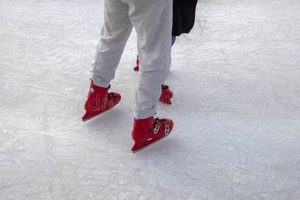Injuries resulting from the sharp blades of ice skates are a recognized hazard in ice-related activities. These injuries typically present as lacerations or punctures caused by accidental contact with a skate’s blade. For instance, a skater falling near another individual can unintentionally cause a deep cut if their skate comes into contact with exposed skin.
The severity of such injuries can range from minor surface abrasions to deep tissue damage, potentially impacting blood vessels, nerves, and tendons. Prompt and appropriate medical attention is crucial to minimize long-term complications, such as infection or permanent functional impairment. Historically, understanding and addressing these risks has led to improvements in safety protocols and protective gear within the sport.
The following sections will delve into the specific types of injuries, preventative measures, and immediate care protocols relevant to minimizing the incidence and impact of lacerations sustained during ice skating activities. This includes a detailed examination of protective equipment efficacy and first aid procedures.
Mitigating Risks Associated with Ice Skate Blades
The following recommendations are provided to reduce the likelihood and severity of injuries stemming from contact with ice skate blades. Adherence to these guidelines can foster a safer environment for all participants.
Tip 1: Employ Appropriate Protective Gear: The use of cut-resistant socks, shin guards, and ankle supports is strongly advised. These items provide a physical barrier, minimizing the potential for skin contact with the skate blade during falls or collisions.
Tip 2: Maintain a Safe Distance: Consciously maintain adequate spacing between individuals on the ice. This reduces the probability of accidental contact with another skater’s blades, particularly during crowded sessions or practices.
Tip 3: Exercise Caution During Transitions: Entering and exiting the ice rink requires heightened awareness. Be mindful of foot traffic and potential obstacles to avoid trips and falls that could result in injury.
Tip 4: Sharpen Blades Regularly: Dull blades necessitate greater force for maneuvers, increasing the risk of instability and accidental contact with other skaters. Regularly sharpen blades to maintain control and reduce the likelihood of uncontrolled movements.
Tip 5: Understand Emergency Procedures: Familiarize yourself with the rink’s emergency protocols, including first aid locations and contact information. This knowledge ensures a prompt and effective response in the event of an injury.
Tip 6: Assess Ice Conditions: Uneven or poorly maintained ice surfaces can increase the risk of falls and subsequent injuries. Prior to skating, observe the ice surface for hazards such as cracks or debris and report any concerns to rink personnel.
Implementing these strategies contributes to a safer skating environment, reducing the potential for serious injuries resulting from interactions with skate blades. Diligence and adherence to these recommendations are paramount.
The subsequent sections will provide a detailed overview of first aid procedures for these types of injuries and will address long-term injury prevention strategies.
1. Severity
The severity of injuries sustained from ice skate blades represents a critical variable directly influencing the required medical intervention and potential long-term consequences. A superficial abrasion requires significantly less intensive care compared to a deep laceration severing tendons or blood vessels. Thus, severity acts as a primary determinant in triage and treatment protocols.
Factors contributing to increased severity include blade sharpness, the force of impact, and the location of the injury. For example, a forceful collision resulting in a deep cut near a major artery presents a life-threatening scenario requiring immediate hemorrhage control and surgical repair. Conversely, a minor cut to the skin may only necessitate basic wound care and monitoring for infection. Protective gear plays a crucial role in mitigating severity, potentially transforming a deep, debilitating injury into a superficial one.
Understanding the potential range of severity is paramount for skaters, coaches, and medical personnel. It informs risk assessment, promotes the use of appropriate safety measures, and enables efficient and effective emergency response. Accurately assessing severity guides the escalation of care and minimizes the potential for long-term complications, underscoring its importance in managing such incidents.
2. Blade Sharpness
Blade sharpness is a primary determinant of the severity and nature of injuries resulting from accidental contact with ice skate blades. The degree to which a blade is sharpened directly impacts its ability to penetrate skin and underlying tissues, thus influencing the depth and characteristics of the resulting cut.
- Penetration Force
A sharper blade requires significantly less force to initiate and propagate a cut compared to a dull blade. This reduced force threshold means that even seemingly minor impacts can result in substantial lacerations. Conversely, a dull blade may require considerably more pressure, potentially leading to crushing injuries rather than clean cuts, although it can still cause a laceration.
- Cut Profile
Sharp blades tend to produce cleaner, more defined cuts with less tissue tearing. This, paradoxically, can sometimes make the injury appear less severe initially, masking the potential depth and involvement of underlying structures. Dull blades, however, often result in ragged, uneven wounds with increased tissue damage, potentially complicating the healing process.
- Controllability and Risk Mitigation
While a sharper blade poses a greater risk of immediate injury, it can also contribute to improved skater control and maneuverability. A well-maintained edge allows for more precise movements, reducing the likelihood of falls and collisions that can lead to uncontrolled contact with other skaters. A dull blade may require more force, increasing instability and elevating the overall risk.
- Protective Equipment Effectiveness
The effectiveness of protective equipment, such as cut-resistant socks and guards, is significantly influenced by blade sharpness. While such gear can offer substantial protection against cuts from relatively dull blades, their ability to withstand penetration from extremely sharp blades may be limited. The material and construction of the protective gear must be carefully considered in relation to the potential sharpness of the blades encountered.
The interplay between blade sharpness and these factors underscores the importance of regular blade maintenance, the use of appropriate protective equipment, and adherence to safe skating practices. The potential for both increased injury severity and improved control necessitates a balanced approach to blade care and risk management within the sport.
3. Laceration Depth
Laceration depth, in the context of injuries from ice skate blades, serves as a critical indicator of tissue damage and potential complications. It dictates the course of treatment, recovery prognosis, and potential for long-term functional impairment. The extent of penetration by a skate blade significantly influences the structures affected and the overall severity of the injury.
- Superficial Lacerations
Superficial lacerations involve the epidermis and dermis, typically resulting in minimal bleeding and discomfort. While less severe, these injuries still pose a risk of infection if not properly cleaned and dressed. In skating scenarios, these can occur from glancing blows or contact with a relatively dull blade. Management generally involves basic wound care and close observation for signs of infection.
- Subcutaneous Lacerations
These injuries extend into the subcutaneous fat layer beneath the skin. Bleeding is more pronounced, and deeper tissues may be affected. Depending on the depth and location, sutures might be necessary to close the wound and promote proper healing. In the context of skating, a fall onto a stationary blade could cause this level of injury. The risk of infection increases, requiring more diligent wound management.
- Muscle Involvement
Lacerations penetrating the muscle tissue represent a significant injury, potentially compromising muscle function. These often require surgical intervention to repair damaged muscle fibers and prevent long-term weakness or disability. Skate blade injuries that occur during high-speed collisions or falls are more likely to result in muscle involvement. Rehabilitation is essential to restore full functionality.
- Neurovascular Compromise
The most severe lacerations involve damage to nerves and blood vessels. These injuries pose a significant threat to limb viability and can result in permanent neurological deficits if not addressed promptly. In the context of skate blade injuries, such involvement is rare but can occur with deep penetrations in areas with major neurovascular bundles, such as the ankle or wrist. Immediate surgical intervention is necessary to restore blood flow and nerve function.
The depth of the laceration from a skate blade is paramount in determining the necessary medical response and potential long-term outcomes. From minor abrasions to life-threatening vascular injuries, the spectrum of potential damage underscores the importance of preventive measures and swift, appropriate medical care in mitigating the consequences of these incidents.
4. Infection Risk
The risk of infection following lacerations sustained from ice skate blades is a significant concern that demands careful consideration. The open nature of these injuries, coupled with the potential for contamination from the skating environment, creates conditions conducive to microbial proliferation. Prompt and appropriate wound management is paramount to mitigate this risk.
- Environmental Contamination
Ice rinks, while seemingly clean, can harbor a variety of microorganisms. Surfaces, including the ice itself and surrounding areas, may be contaminated with bacteria and fungi. Skate blades, in contact with these surfaces, can introduce pathogens into the wound during an injury. This necessitates thorough cleaning and disinfection of the wound site.
- Bacterial Colonization
Human skin naturally hosts a diverse population of bacteria. When the skin barrier is breached by a skate blade, these resident bacteria can gain access to deeper tissues, potentially leading to localized or systemic infections. Staphylococcus aureus and Streptococcus pyogenes are common skin commensals that can become opportunistic pathogens in such scenarios. Antibiotic therapy may be warranted in severe cases.
- Foreign Body Introduction
Fragments of clothing, ice, or other debris can be embedded within the wound during the injury event. These foreign bodies not only introduce additional microorganisms but also create a nidus for infection, hindering the body’s natural defenses and impeding the healing process. Careful wound exploration and debridement are essential to remove any foreign material.
- Delayed Wound Closure
Factors that delay wound closure, such as inadequate wound cleaning, poor blood supply, or underlying medical conditions, increase the susceptibility to infection. Open wounds provide a portal of entry for pathogens and prolong the period during which the wound is vulnerable to contamination. Proper wound closure techniques and management of underlying health issues are crucial for minimizing infection risk.
The interplay of these factors underscores the importance of comprehensive wound care protocols following injuries from ice skate blades. From immediate wound cleansing to diligent monitoring for signs of infection, a proactive approach is essential to prevent potentially serious complications and ensure optimal healing outcomes. Failure to address these concerns can result in prolonged recovery times, increased medical costs, and, in rare cases, life-threatening systemic infections.
5. Protective Gear
Protective gear constitutes a critical intervention in mitigating the severity and incidence of injuries caused by ice skate blades. The primary function of such equipment is to provide a physical barrier between the blade and the skater’s skin and underlying tissues, thereby reducing the likelihood of lacerations or punctures. The efficacy of protective measures is directly related to the material properties, design, and proper fit of the gear.
Cut-resistant fabrics, often incorporating materials like Kevlar or Spectra, are employed in socks, shin guards, and ankle supports designed for ice skating. These materials exhibit a high tensile strength and resistance to penetration, effectively distributing the force of impact over a wider area and preventing the blade from cutting through. In professional hockey, for example, the mandatory use of neck guards has demonstrably reduced the incidence of severe neck lacerations from skate blades. Similarly, specialized skating pants with reinforced panels in high-risk areas offer increased protection during falls or collisions.
While protective gear cannot eliminate the risk of injuries from ice skate blades entirely, its consistent and proper use significantly reduces the potential for severe lacerations. The effectiveness is contingent upon adhering to recommended safety standards and selecting gear appropriate for the level of skating activity. Further research into advanced materials and innovative designs is ongoing to enhance the protective capabilities of such equipment, reinforcing its importance in promoting a safer skating environment.
6. First Aid
The immediate application of first aid principles to injuries resulting from ice skate blades is crucial in mitigating potential complications and optimizing patient outcomes. Rapid and appropriate intervention can significantly reduce the risk of infection, minimize blood loss, and preserve tissue viability, thereby impacting long-term recovery.
- Immediate Hemorrhage Control
Controlling bleeding is the initial priority in managing skate blade lacerations. Direct pressure applied to the wound site using a clean cloth or sterile dressing serves to stem the flow of blood, facilitating clot formation. Elevation of the injured extremity above the heart can further reduce hydrostatic pressure and minimize blood loss. In cases of severe arterial bleeding, tourniquet application may be necessary, though this requires specialized training and careful monitoring to prevent ischemic injury. Prompt and effective hemorrhage control can prevent hypovolemic shock and create a more stable environment for further assessment and treatment.
- Wound Assessment and Cleaning
Following hemorrhage control, a thorough assessment of the wound is essential. This involves evaluating the depth, extent, and location of the laceration, as well as identifying any potential damage to underlying structures such as tendons, nerves, or blood vessels. Gentle irrigation of the wound with sterile saline or clean water is crucial to remove debris and contaminants. The use of antiseptic solutions, such as povidone-iodine or chlorhexidine, may be considered to further reduce the risk of infection, although caution should be exercised to avoid tissue toxicity.
- Wound Closure and Dressing
Depending on the size, depth, and location of the laceration, various wound closure techniques may be employed. Small, superficial cuts may heal spontaneously with proper wound care, while deeper or more extensive wounds may require sutures, staples, or adhesive bandages to approximate the wound edges and promote healing. After closure, a sterile dressing should be applied to protect the wound from contamination and provide a moist environment conducive to tissue regeneration. Regular dressing changes and monitoring for signs of infection are essential components of ongoing wound care.
- Immobilization and Splinting
If the laceration involves an extremity, immobilization and splinting may be necessary to prevent further injury and promote healing. Splinting can reduce pain, minimize swelling, and protect damaged tissues from movement or weight-bearing. This is particularly important if there is suspected damage to tendons or ligaments. Crutches or other assistive devices may be required to ambulate without placing stress on the injured area. The duration of immobilization will depend on the severity of the injury and the individual’s response to treatment.
These first aid interventions, when implemented effectively, can significantly influence the trajectory of recovery from injuries sustained from ice skate blades. The prompt application of these principles minimizes complications, reduces the need for extensive medical intervention, and facilitates a faster return to activity. Moreover, adequate first aid training empowers individuals to respond confidently and competently in emergency situations, potentially averting long-term disability.
7. Mechanism of Injury
The mechanism of injury provides critical insights into the specific circumstances surrounding lacerations sustained from ice skate blades. Understanding the precise sequence of events leading to the injury allows for a more comprehensive assessment of its severity and informs strategies for prevention. For instance, a laceration resulting from a direct collision between two skaters will differ significantly from one caused by a skater falling onto their own blade. The angle of impact, the force of contact, and the position of the victim relative to the blade all contribute to the nature and extent of the resulting wound.
Consider the example of a hockey player receiving a deep cut to the leg after falling and being inadvertently stepped on by another player’s skate. In this scenario, the mechanism involves a combination of the skater’s body weight, the sharpness of the blade, and the downward force applied during the stepping motion. Conversely, a figure skater sustaining a superficial cut to the hand while adjusting their skate laces represents a different mechanism of injury, involving a lower force and a more controlled interaction with the blade. Analyzing these distinct mechanisms helps to identify specific risk factors and target preventative measures accordingly. For example, improved spatial awareness training for hockey players or modified skate lacing techniques for figure skaters.
In conclusion, analyzing the mechanism of injury is paramount for effectively addressing incidents involving ice skate blade injuries. By understanding how these lacerations occur, one can develop targeted strategies for prevention and ensure prompt, appropriate medical care. This approach enhances safety protocols and minimizes the potential for severe outcomes in ice-related activities, leading to a safer environment for skaters of all levels.
Frequently Asked Questions
The following section addresses common inquiries regarding injuries sustained from ice skate blades. The information presented aims to clarify concerns and promote informed safety practices.
Question 1: What factors contribute to the severity of a laceration from an ice skate blade?
The depth of the cut, sharpness of the blade, force of impact, and location of the injury significantly influence the severity. Deeper cuts, sharper blades, and greater force typically result in more severe injuries. Proximity to major blood vessels or nerves also increases the potential for complications.
Question 2: Is there a reliable way to prevent injuries from skate blades?
While no method guarantees complete prevention, consistent use of appropriate protective gear, maintaining a safe distance from other skaters, and practicing caution during transitions significantly reduce the risk. Regular blade maintenance and awareness of ice conditions are also important preventative measures.
Question 3: What immediate steps should be taken if a skate blade cut occurs?
Immediate hemorrhage control is the first priority. Direct pressure should be applied to the wound using a clean cloth. Elevating the injured limb can also help reduce bleeding. Subsequently, the wound should be cleaned with sterile saline or clean water. Seek professional medical attention promptly.
Question 4: Are all skate blade injuries prone to infection?
All open wounds carry a risk of infection. Skate blade injuries are no exception, especially given potential contamination from the skating environment. Thorough wound cleaning and adherence to proper wound care protocols are crucial to minimizing the risk of infection. Watch for signs of infection, such as redness, swelling, pus, and increased pain, and seek medical attention promptly if such signs appear.
Question 5: What role does protective gear play in mitigating such injuries?
Protective gear, such as cut-resistant socks and shin guards, provides a physical barrier between the skate blade and the skin. This reduces the likelihood of lacerations or punctures. The effectiveness of the gear depends on the material properties, design, and proper fit.
Question 6: Are dull blades safer than sharp blades?
While a dull blade may reduce the risk of clean lacerations, it necessitates greater force for skating maneuvers, which can increase the risk of falls and subsequent injuries. Sharp blades, when properly controlled, provide better maneuverability and reduce the likelihood of uncontrolled movements. Blade maintenance and skater proficiency are key factors in safety.
Proper prevention, quick first aid, and diligent wound care are paramount when dealing with ice skate cut injuries.
Next section will explore resources for more information.
Concluding Observations on Ice Skate Cuts
This exploration of ice skate cuts has underscored the multifaceted nature of these injuries, highlighting the interplay between blade sharpness, protective gear, and immediate first aid. The severity of lacerations, the risk of infection, and the mechanism of injury each contribute significantly to the overall impact. Addressing these factors through preventive measures and prompt medical intervention is paramount in minimizing potential harm.
Continued vigilance and adherence to established safety protocols remain essential in mitigating the risks associated with ice skating activities. Prioritizing skater safety through ongoing education and technological advancements in protective equipment will contribute to a safer environment for all participants and reduce the incidence and impact of ice skate cuts.







